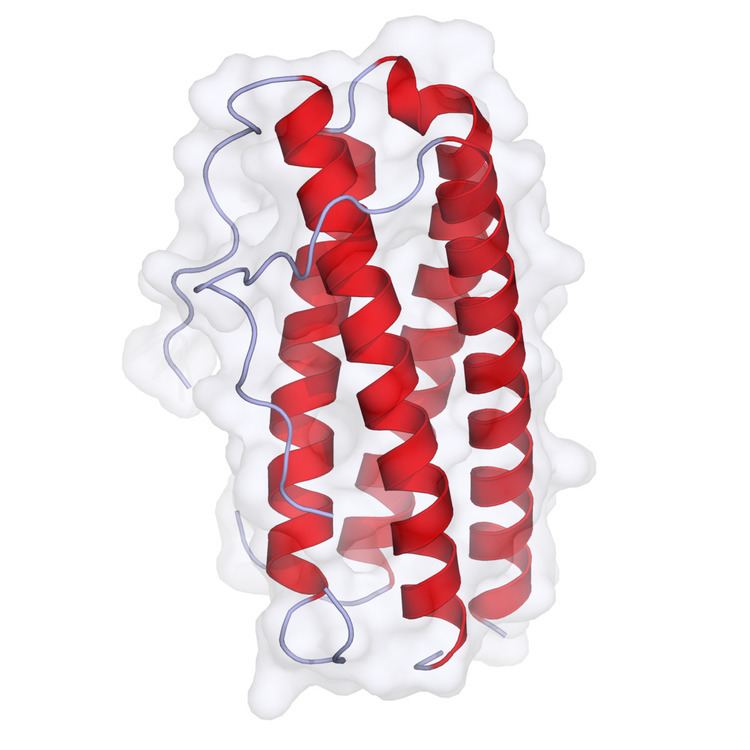Entrez 3589 | Ensembl ENSG00000095752 | |
 | ||
Aliases IL11, AGIF, IL-11, interleukin 11 External IDs OMIM: 147681 MGI: 107613 HomoloGene: 535 GeneCards: IL11 | ||
Interleukin 11 (IL-11) is a protein that in humans is encoded by the IL11 gene.
Contents
IL-11 is a multifunctional cytokine first isolated in 1990 from bone marrow-derived stromal cells. It is a key regulator of multiple events in hematopoiesis, most notably the stimulation of megakaryocyte maturation. It is also known under the names adipogenesis inhibitory factor (AGIF) and oprelvekin.
The human IL-11 gene, consisting of 5 exons and 4 introns, is located on chromosome 19, and encodes a 23 kDa protein. IL-11 is a member of the IL-6-type cytokine family, distinguished based on their use of the common co-receptor gp130. Signal specificity is provided by the IL-11Rα subunit.
Downstream signalling
Signal transduction is initiated upon binding of IL-11 to IL-11Ralpha and gp130, facilitating the homodimerization of gp130 molecules. This permits gp130-associated Janus kinases (JAK) to become activated and phosphorylate intracellular tyrosine residues on gp130.
Function
IL-11 has been demonstrated to improve platelet recovery after chemotherapy-induced thrombocytopenia, induce acute phase proteins, modulate antigen-antibody responses, participate in the regulation of bone cell proliferation and differentiation IL-11 causes bone-resorption. It stimulates the growth of certain lymphocytes and, in the murine model, stimulates an increase in the cortical thickness and strength of long bones. In addition to having lymphopoietic/hematopoietic and osteotrophic properties, it has functions in many other tissues, including the brain, gut, testis and bone.
As a signaling molecule, interleukin 11 has a variety of functions associated with its receptor interleukin 11 receptor alpha; such functions include placentation and to some extent of decidualization. IL11 has been expressed to have a role during implantation of the blastocyst in the endometrium of the uterus; as the blastocyst is imbedded within the endometrium, the extravillous trophoblasts will invade the maternal spiral arteries for stability and the transfer of essential life-sustaining elements via the maternal and fetal circulatory systems. This process is highly regulated due to detrimental consequences that can arise from aberrations of the placentation process: poor infiltration of the trophoblasts may result in preeclampsia while severely invasive trophoblasts may resolve in placenta accreta, increta or percreta; all defects which most likely would result in the early demise of the embryo and/or negative effects upon the mother. IL11 has been shown to be present in the decidua and chorionic villi to regulate the extent in which the placenta implants itself; regulations to ensure the well-being of the mother but also the normal growth and survival of the fetus. A murine knockout model has been produced for this particular gene, with initial studies involving IL11 role in bone pathologies but have since progressed to fertility research; further research utilizes endometrial and gestational tissue from humans.
Medical use
Interleukin 11 is manufactured using recombinant DNA technology and is marketed as a protein therapeutic called oprelvekin, for the prevention of severe thrombocytopenia in cancer patients.
Research
Many IL-11 functions associated with cell growth and differentiation suggest a role for this cytokine in cancer. A number of studies reported IL-11 as a possible cancer progression marker suggesting that therapeutic targeting of IL-11 or IL11RA in humans may be beneficial, however as of 2017 clinically relevant blockers of IL-11 signaling were still under development.
